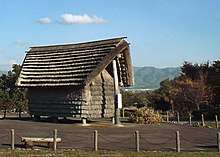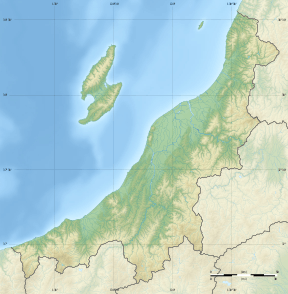Fujihashi Site
The Fujihashi Site (藤橋遺跡, Fujihashi Iseki) is an archaeological park containing the remnants of a middle Jōmon period settlement located in what is now part of the city of Nagaoka, Niigata in the Hokuriku region of Japan. The site was designated a National Historic Site of Japan in 1978.[1]
藤橋遺跡 | |
 Reconstructed dwelling at Fujihashi Site | |
 Fujihashi Site  Fujihashi Site (Japan) | |
| Location | Nagaoka, Niigata, Japan |
|---|---|
| Region | Hokuriku region |
| Coordinates | 37°25′41″N 138°46′56″E |
| Type | Settlement |
| History | |
| Founded | Jōmon |
| Site notes | |
| Ownership | National Historic Site |
| Public access | Yes |
Overview
The site is located on a river terrace of the Shinano River and contains the ruins of a large village from the middle of the Jomon period (3,000 years ago). The first survey of the site was conducted by the Nagaoka Municipal Science Museum in 1951, and several excavations have followed at later dates. In addition to various stone tools (including stone axes) and the foundations of pit dwellings and raised floor structures, a typical design of pottery known as the "Fujihashi style" was discovered. Also found within the site was a production area for jadeite stone balls.
The site is open to the public as an archaeological park with reconstructions of buildings, and includes the "Fujihashi History Plaza" - a museum containing models, panels, and restored excavated items.
References
- "藤橋遺跡" [Fujihashi Iseki] (in Japanese). Agency for Cultural Affairs.
External links
- Nagaoka City Tourist Information home page (in Japanese)